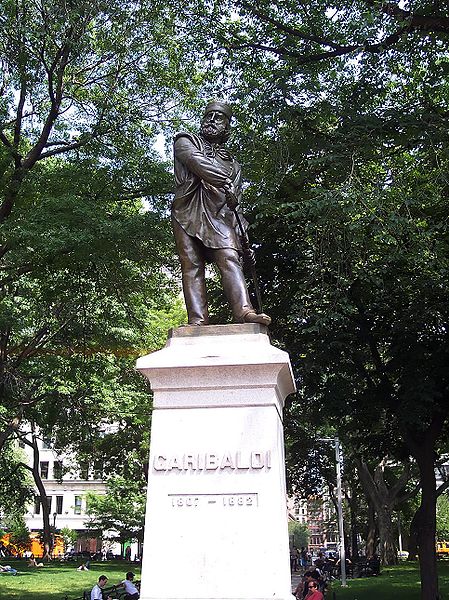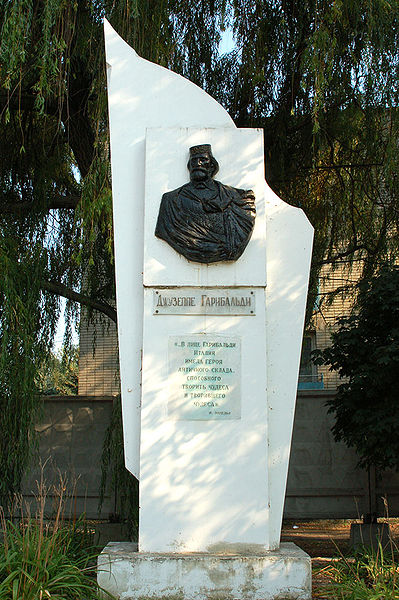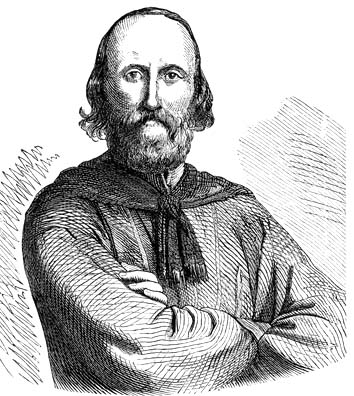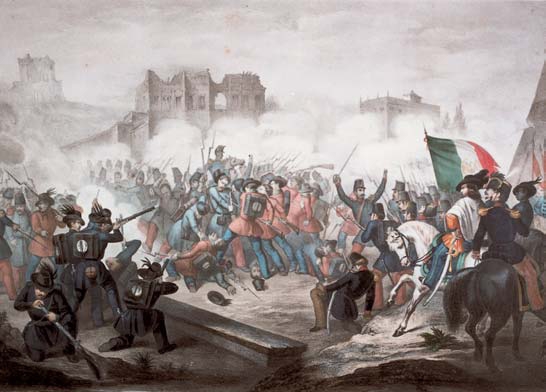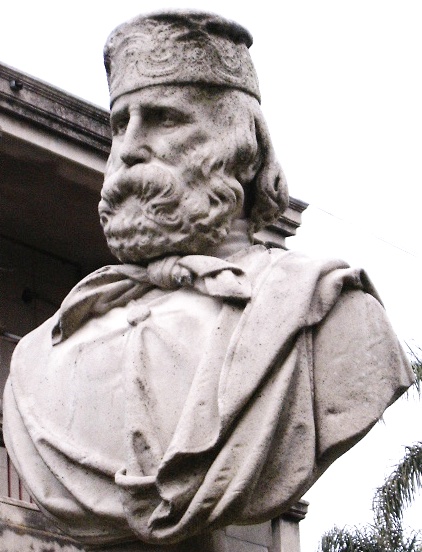<Back to Index>
- Surveyor Colonel Sir George Everest, 1790
- Novelist Nathaniel Hawthorne, 1804
- Revolutionary of the Risorgimento Giuseppe Garibaldi, 1807
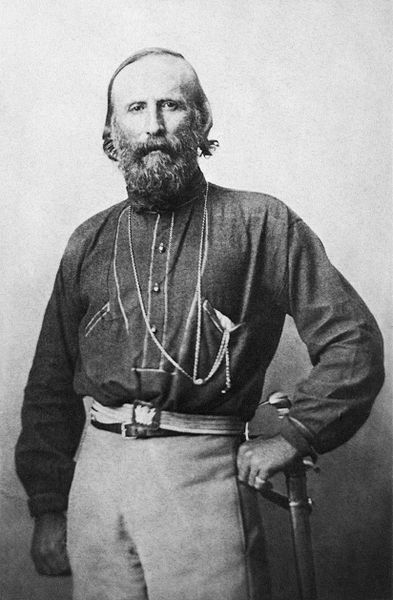
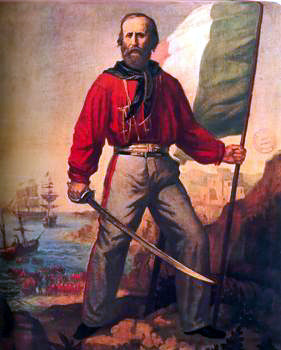
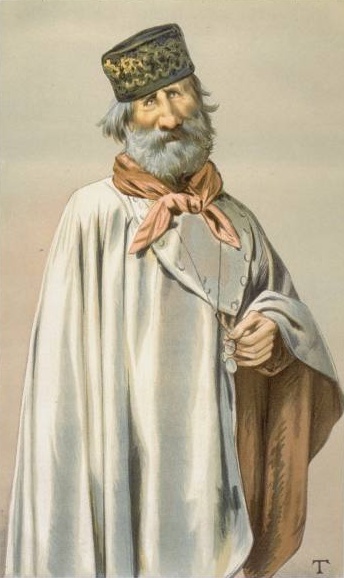
Giuseppe Garibaldi (July 4, 1807 – June 2, 1882) was an Italian military and political figure. In his twenties, he joined the Carbonari Italian patriot revolutionaries, and had to flee Italy after a failed insurrection. Garibaldi took part in the War of the Farrapos and the Uruguayan Civil War leading the Italian Legion, and afterwards returned to Italy as a commander in the conflicts of the Risorgimento. He has been dubbed the "Hero of the Two Worlds" in tribute to his military expeditions in both South America and Europe. He is considered an Italian national hero. Giuseppe Garibaldi was born on July 4, 1807 in the city of Nice (Italian:Nizza), at that time the capital of the French department of Alpes-Maritimes, before it was given back to the House of Savoy, the rulers of the Kingdom of Sardinia, in 1814 with Napoleon's
defeat. In 1860, however, the Savoys returned the city to France (an
action opposed by Garibaldi), to get French aid in Italy's unification
wars. Garibaldi's family was involved in coastal trade, and he was
drawn to a life on the sea. He participated actively in the community
of the Nizzardo Italians and was certified in 1832 as a merchant marine captain. A very influential day in Garibaldi's life came while visiting Taganrog, Russia, in April 1833, where he moored for ten days with the schooner Clorinda and a shipment of oranges. In a seaport inn, he met Giovanni Battista Cuneo from Oneglia, a political immigrant from Italy and member of the secret movement La Giovine Italia ("Young Italy"), founded by Giuseppe Mazzini, an impassioned proponent of Italian unification as a liberal republic through
political and social reforms. Garibaldi joined the society, and took an
oath of dedicating his life to struggle for liberation of his homeland
from Austrian dominance. In Geneva in
November 1833, Garibaldi met Mazzini himself, starting a relationship
that later would become rather troublesome. He joined the Carbonari revolutionary association. In February 1834 he participated in a failed Mazzinian insurrection in Piedmont, was sentenced to death in absentia by a Genoese court, and fled to Marseilles.
Garibaldi first sailed to Tunisia before eventually finding his way to Brazil. There he took up the cause of independence of the Republic of Rio Grande do Sul (the former Brazilian province of São Pedro do Rio Grande do Sul), joining the gaucho rebels known as the farrapos (tatters) against the newly independent Brazilian nation (War of Tatters). During this war he met a woman, Ana Ribeiro da Silva (best known as "Anita"), when the Tatters Army tried to proclaim another republic in the Brazilian province of Santa Catarina. In October 1839, Anita joined Garibaldi on his ship, the Rio Pardo. A month later, she fought at her lover's side at the battles of Imbituba and Laguna. In 1841, the couple moved to Montevideo, Uruguay,
where Garibaldi worked as a trader and schoolmaster, and married there
the following year. They had four children, Menotti (born 1840), Rosita
(born 1843), Teresita (born 1845) and Ricciotti (born 1847). A skilled
horsewoman, Anita is said to have taught Giuseppe about the gaucho
culture of southern Brazil and Uruguay. It was about this time that he
adopted his trademark clothing, the red shirt, cloak (poncho), and
sombrero (hat) used by the gauchos.
In 1842, Garibaldi took command of the Uruguayan fleet and raised an "Italian Legion" for the Uruguayan Civil War, aligned with the liberal coalition of Uruguayan Colorados of Fructuoso Rivera and Argentine Unitarios (with substantive support of France and United Kingdom) against the conservative forces of former Uruguayan president Manuel Oribe's Blancos and Argentine Federales under the rule of Buenos Aires caudillo Juan Manuel de Rosas.
The Legion adopted a black flag representing Italy in mourning, while
the volcano at its center symbolized the dormant power in their
homeland. Though there is no contemporary mention of them, popular
history asserts that it was in Uruguay that the legion first wore the red shirts, said to have been obtained from a factory in Montevideo which had intended to export them to the slaughter houses of Argentina.
It was to become the symbol of Garibaldi and his followers. Between
1842 and 1848, Garibaldi defended Montevideo against forces being led
by Oribe. In 1845, he even managed to occupy Colonia del Sacramento and Isla Martín García and led the controversial sack of Gualeguaychú.
Adopting skillful guerrilla tactics, he achieved two celebrated
victories in the battles of Cerro and San Antonio del Santo in 1846. The fate of his homeland, however, continued to concern Garibaldi. The election of Pope Pius IX in
1846 had caused a sensation among Italian patriots, both at home and in
exile. When news of the Pope's initial reforms (which seemed to
identify him as the liberal pope prophesied by Vincenzo Gioberti, who would provide the leadership for the unification of Italy) reached Montevideo, Garibaldi wrote the following letter: Also Mazzini, from his exile, applauded the first reforms of Pius IX. In 1847, Garibaldi offered the apostolic nuncio at
Rio de Janeiro, Bedini, the service of his Italian Legion for the
liberation of the peninsula. News of the outbreak of revolution in Palermo in January 1848 and revolutionary agitation elsewhere in Italy encouraged Garibaldi to lead some 60 members of his legion home. Garibaldi returned to Italy amongst the turmoil of the revolutions of 1848, and offered his services to Charles Albert of Sardinia.
The monarch displayed some liberal inclinations, but treated Garibaldi
with coolness and distrust. Rebuffed by the Piedmontese, he and his
followers crossed into Lombardy where they offered assistance to the
provisional government of Milan, which had rebelled against the
Austrian occupation. In the course of the following, unsuccessful First Italian War of Independence, he led his legion to two minor victories at Luino and Morazzone. After the crushing Piedmontese defeat at Novara (March 23, 1849), Garibaldi moved to Rome to support the Republic which had been proclaimed in the Papal States, but a French force sent by Louis Napoleon (the future Napoleon III) threatened to topple it. At Mazzini's urging, Garibaldi took up the command of the defence of Rome. In fighting near Velletri, Achille Cantoni saved his life. On
April 30, 1849 the Republican army, under the command of Garibaldi,
defeated a numerically far superior French army. Subsequently,
additional French reinforcements arrived and the siege of Rome began on
June 1. Despite the resistance of the Republican army, led by
Garibaldi, the French prevailed on June 29. On June 30 the Roman
Assembly met and debated three options : to surrender; to continue
fighting in the streets of Rome; to retreat from Rome and continue the
resistance from the Apennine mountains. Garibaldi made a speech in
which he favored the third option and then said: Dovunque saremo, colà sarà Roma. (Wherever we may be, there will be Rome). A
truce was negotiated on July 1, and on July 2 Garibaldi withdrew from
Rome with 4,000 troops. The French Army entered Rome on July 3 and
reestablished the Holy See's temporal power. Garibaldi and his forces, hunted by Austrian, French, Spanish, and Neapolitan troops, fled to the north with the intention to reach Venice, where the Venetians were still resisting the Austrian siege. After an epic march, Garibaldi took momentary refuge in San Marino, with only 250 men still following him. Anita, who was carrying their fifth child, died near Comacchio during the retreat. Garibaldi eventually managed to reach Portovenere, near La Spezia, but the Piedmontese government forced him to emigrate abroad again. After a stay in Tangier, he moved on to Staten Island, New York.
He arrived on the 30th of July 1850, and stayed in exile in an attempt
to avoid publicity and exposure. His host was the inventor Antonio Meucci, where he spent some time working as a candlemaker in his plant on Staten Island,
but was dissatisfied by the result. Afterwards he made several voyages
as sea captain to the Pacific, the longest of which took two years from
April 1851, during which he visited Andean revolutionary heroine Manuela Sáenz in Peru. Garibaldi left New York for the last time in November 1853. The cottage on Staten Island where he stayed during 1851-1853 is listed on the U.S. National Register of Historic Places and is preserved as Garibaldi Memorial. On March 21, 1854, Garibaldi sailed into the mouth of the River Tyne in north eastern England, as Master of the sailing vessel Commonwealth. The ship had sailed from Baltimore and was flying the American flag when it docked and unloaded its cargo in South Shields. Garibaldi, already a popular figure on Tyneside, was welcomed enthusiastically by the local working class, although the Newcastle Courant reported that he refused an invitation to dine with dignitaries in nearby Newcastle.
As a memento of his stay in the area, an inscribed sword, paid for
through public subscriptions, was presented to Garibaldi. His grandson carried the sword to South Africa with him almost half a century later, when he volunteered to fight for the British Army in the Boer War. In total, Garibaldi stayed in Tyneside for over a month, departing at the end of April 1854. Garibaldi returned again to Italy in 1854. Using a legacy from the death of his brother, he bought half of the Italian island of Caprera (north of Sardinia), devoting himself to agriculture. In 1859, the Second Italian War of Independence (also
known as the Austro-Sardinian War) broke out in the midst of internal
plots at the Sardinian government. Garibaldi was appointed major general, and formed a volunteer unit named the Hunters of the Alps (Cacciatori delle Alpi).
Thenceforth, Garibaldi abandoned Mazzini's republican ideal of the
liberation of Italy, assuming that only the Piedmontese monarchy could
effectively achieve it. With his volunteers, he won victories over the Austrians at Varese, Como, and other places. Garibaldi was however very displeased as his home city of Nice (Nizza in
Italian) was surrendered to the French, in return for crucial military
assistance. In April 1860, as deputy for Nice in the Piedmontese
parliament at Turin, he vehemently attacked Cavour for ceding Nice and
the County of Nice (Nizzardo) to Louis Napoleon, Emperor of the French. In the following years Garibaldi (with other passionate Nizzardo Italians) promoted the Irredentism of his Nizza, even with riots (in 1872). On
January 24, 1860, Garibaldi married an 18-year-old Lombard noblewoman,
Giuseppina Raimondi. Immediately after the wedding ceremony, however,
she informed him that she was pregnant with another man's child; as a
result, Garibaldi left her the same day. At the beginning of April 1860, uprisings in Messina and Palermo in the independent and peaceful Kingdom of the Two Sicilies provided Garibaldi with an opportunity. He gathered about a thousand volunteers (practically all northern Italians, and called i Mille (the Thousand), or, as popularly known, the Redshirts) in two ships, and landed at Marsala, on the westernmost point of Sicily, on May 11. Swelling
the ranks of his army with scattered bands of local rebels, Garibaldi
led 800 of his volunteers to victory over a 1500-strong enemy force on
the hill of Calatafimi on May 15. He used the counter-intuitive tactic
of an uphill bayonet charge; he had seen that the hill on which the
enemy had taken position was terraced, and the terraces gave shelter to
his advancing men. Although small by comparison with the coming clashes
at Palermo, Milazzo and Volturno, this battle was decisive in terms of
establishing Garibaldi's power in the island; an apocryphal but
realistic story had him say to his lieutenant Nino Bixio, Qui si fa l'Italia o si muore, that is, Here we either make Italy, or we die.
In reality, the Neapolitan forces were ill guided, and most of its
higher officers had been bought out. The next day, he declared himself
dictator of Sicily in the name of Victor Emmanuel II of Italy. He advanced then to Palermo, the capital of the island, and launched a siege on
May 27. He had the support of many of the inhabitants, who rose up
against the garrison, but before the city could be taken,
reinforcements arrived and bombarded the city nearly to ruins. At this
time, a British admiral intervened and facilitated an armistice, by
which the Neapolitan royal troops and warships surrendered the city and departed. Garibaldi
had won a single victory. He gained worldwide renown and the adulation
of Italians. Faith in his prowess was so strong that doubt, confusion,
and dismay seized, even the Neapolitan court. Six weeks later, he
marched against Messina in the east of the island. There was a
ferocious and difficult battle at Milazzo, but Garibaldi won through.
By the end of July, only the citadel resisted. Garibaldi deeply disliked the Piedmontese Prime Minister, Camillo Benso, conte di Cavour. To an extent, he simply mistrusted Cavour's pragmatism and realpolitik,
but he also bore a personal grudge for trading away his home city of
Nice to the French the previous year. On the other hand, he felt
attracted toward the Piedmontese monarch, who in his opinion had been
chosen by Providence for the liberation of Italy. In his famous meeting
with Victor Emmanuel II at Teano on October 26, 1860, Garibaldi greeted him as King of Italy and shook his hand. Garibaldi rode into Naples at the king's side on November 7, then retired to the rocky island of Caprera, refusing to accept any reward for his services. On October 5 Garibaldi set up the International Legion bringing together different national divisions of French, Poles, Swiss,
German and other nationalities, with a view not just of finishing the
liberation of Italy, but also of their homelands. With the motto "Free
from the Alps to the Adriatic",
the unification movement set its gaze on Rome and Venice. Mazzini was
discontented with the perpetuation of monarchial government, and
continued to agitate for a republic. Garibaldi, frustrated at inaction
by the king, and bristling over perceived snubs, organized a new
venture. This time, he intended to take on the Papal States. At the outbreak of the American Civil War (in 1861), Garibaldi volunteered his services to President Abraham Lincoln. Garibaldi was offered a Major General's commission in the U. S. Army through the letter from Secretary of State William H. Seward to H.S. Sanford, the U. S. Minister at Brussels, July 17, 1861. On September 18, 1861, Sanford sent the following reply to Seward: He
[Garibaldi] said that the only way in which he could render service, as
he ardently desired to do, to the cause of the United States, was as
Commander-in-chief of its forces, that he would only go as such, and
with the additional contingent power - to be governed by events - of
declaring the abolition of slavery; that he would be of little use
without the first, and without the second it would appear like a civil
war in which the world at large could have little interest or sympathy. According
to Italian historian Petacco, "Garibaldi was ready to accept Lincoln's
1862 offer but on one condition: that the war's objective be declared
as the abolition of slavery. But at that stage Lincoln was unwilling to
make such a statement lest he worsen an agricultural crisis." On August 6, 1863, after the Emancipation Proclamation had been issued, Garibaldi wrote to Lincoln: Posterity
will call you the great emancipator, a more enviable title than any
crown could be, and greater than any merely mundane treasure. A challenge against the Pope's temporal domain was viewed with great distrust by Catholics around the world, and the French emperor Napoleon III had
guaranteed the independence of Rome from Italy by stationing a French
garrison in Rome. Victor Emmanuel was wary of the international
repercussions of attacking the Papal States, and discouraged his
subjects from participating in revolutionary ventures with such
intentions. Nonetheless, Garibaldi believed he had the secret support
of his government. In June 1862, he sailed from Genoa and landed at Palermo, seeking to gather volunteers for the impending campaign under the slogan Roma o Morte (Rome
or Death). An enthusiastic party quickly joined him, and he turned for
Messina, hoping to cross to the mainland there. When he arrived, he had
a force of some two thousand, but the garrison proved loyal to the
king's instructions and barred his passage. They turned south and set
sail from Catania, where Garibaldi declared that he would enter Rome as a victor or perish beneath its walls. He landed at Melito on August 14, and marched at once into the Calabrian mountains. Far from supporting this endeavor, the Italian government was quite disapproving. General Enrico Cialdini dispatched a division of the regular army, under Colonel Pallavicino, against the volunteer bands. On August 28 the two forces met in the rugged Aspromonte.
One of the regulars fired a chance shot, and several volleys followed,
killing a few of the volunteers. The fighting ended quickly, as
Garibaldi forbade his men to return fire on fellow subjects of the Kingdom of Italy.
Many of the volunteers were taken prisoner, including Garibaldi, who
had been wounded by a shot in the foot. This episode gave birth to a
famous Italian nursery rhyme, still known by boys and girls all over the country: Garibaldi fu ferito ("Garibaldi was wounded"). A government steamer took him to Varignano,
where he was held in a sort of honorable imprisonment, and was
compelled to undergo a tedious and painful operation for the healing of
his wound. His venture had failed, but he was at least consoled by
Europe's sympathy and continued interest. After being restored to
health, he was released and allowed to return to Caprera. In 1864 he visited London, where his presence was received with enthusiasm by the population. He met the British prime minister Henry Palmerston,
as well as other revolutionaries then living in exile in the city. At
that time, his ambitious international project included the liberation
of a range of occupied nations, such as Croatia, Greece, Hungary, but
none of them turned into reality. Garibaldi took up arms again in 1866, this time with the full support of the Italian government. The Austro-Prussian War had broken out, and Italy had allied with Prussia against Austria-Hungary in the hope of taking Venetia from Austrian rule (Third Italian War of Independence). Garibaldi gathered again his Hunters of the Alps, now some 40,000 strong, and led them into the Trentino. He defeated the Austrians at Bezzecca (thus securing the only Italian victory in that war) and made for Trento. The Italian regular forces were defeated at Lissa on the sea, and made little progress on land after the disaster of Custoza.
An armistice was signed, by which Austria ceded Venetia to Italy, but
this result was largely due to Prussia's successes on the northern
front. Garibaldi's advance through Trentino was for nought and he was
ordered to stop his advance to Trento. Garibaldi answered with a short
telegram from the main square of Bezzecca with the famous motto: Obbedisco! ("I obey!"). After the war, Garibaldi led a political party that
agitated for the capture of Rome, the peninsula's ancient capital. In
1867, he again marched on the city, but the Papal army, supported by a
French auxiliary force, proved a match for his badly-armed volunteers.
He was shot and wounded in the leg in the Battle of Mentana,
and had to withdraw out of the Papal territory. The Italian government
again imprisoned and held him for some time, after which he again
returned to Caprera. In the same year, Garibaldi sought international
support for altogether eliminating the papacy. At an 1867 congress in Geneva he proposed: "The papacy, being the most harmful of all secret societies, ought to be abolished." When the Franco-Prussian War broke
out in July 1870, Italian public opinion heavily favored the Prussians,
and many Italians attempted to sign up as volunteers at the Prussian
embassy in Florence. After the French garrison was recalled from Rome,
the Italian Army captured the Papal States without Garibaldi's
assistance. Following the wartime collapse of the Second French Empire at
the battle of Sedan, Garibaldi, undaunted by the recent hostility shown
to him by the men of Napoleon III, switched his support to the
newly-declared French Third Republic. On 7 September 1870, within three days of the revolution of 4 September in Paris, he wrote to the Movimento of
Genoa: "Yesterday I said to you: war to the death to Bonaparte. Today I
say to you: rescue the French Republic by every means." Subsequently, Garibaldi went to France and assumed command of the Army of the Vosges, an army of volunteers that was never defeated by the Prussians. Despite being elected again to the Italian parliament, Garibaldi spent much of his late years in Caprera. He however supported an ambitious project of land reclamation in the marshy areas of southern Lazio. In 1879 he founded the "League of Democracy", advocating universal suffrage, the abolition of ecclesiastical property, emancipation of women, and maintenance of the standing army. Ill and confined to a bed by arthritis, he made trips to Calabria and Sicily. In 1880 he married Francesca Armosino, with whom he had previously had three children. On
his deathbed, Garibaldi asked that his bed be moved to where he could
gaze at the emerald and sapphire sea. Upon his death on June 2, 1882 at
the age of almost 75, his wishes for a simple funeral and cremation
were not respected. He is buried on his farm on the island of Caprera
alongside his last wife and some of his children.
Having finished the conquest of Sicily, he crossed the Strait of Messina,
with the help of the British Navy, and marched northward. Garibaldi's
progress was met with more celebration than resistance, and on
September 7 he entered the capital city of Naples,
by train. Despite taking Naples, however, he had not to this point
defeated the Neapolitan army. Garibaldi's volunteer army of 24,000 was
not able to defeat conclusively the reorganized Neapolitan army (about
25,000 men) on September 30 at the Battle of Volturno.
This was the largest battle he ever fought, but its outcome was
effectively decided by the arrival of the Piedmontese Army. Following
this, Garibaldi's plans to march on to Rome were jeopardized by the
Piedmontese, technically his ally but unwilling to risk war with
France, whose army protected the Pope. (The Piedmontese themselves had
conquered most of the Pope's territories in their march south to meet
Garibaldi, but they had deliberately avoided Rome, his capital.)
Garibaldi chose to hand over all his territorial gains in the south to
the Piedmontese and withdrew to Caprera and temporary retirement. Some
modern historians consider the handover of his gains to the Piedmontese
as a political defeat, but he seemed willing to see Italian unity
brought about under the Piedmontese crown. The meeting at Teano between
Garibaldi and Victor Emmanuel II is the most important event in modern
Italian history, but is so shrouded in controversy that even the exact
site where it took place is in doubt.
